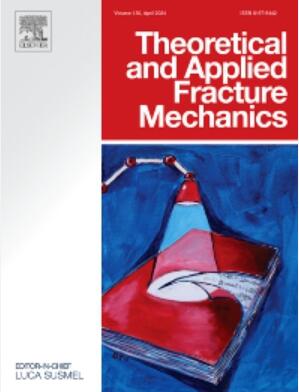Fatigue crack growth rate under mixed-mode loading conditions (I+III) of a carbide-free bainitic steel designed for rail applications
IF 5
2区 工程技术
Q1 ENGINEERING, MECHANICAL
引用次数: 0
Abstract
Carbide-free bainitic steel was designed for railway infrastructure application, focusing on high-speed and heavy-loaded freight tracks. Considering the complex state of stresses occurring on the rails running surface, mode III plays a significant role in the initiation and propagation of fatigue cracks of rails during service. Thus, the Fatigue Crack Growth Rate (FCGR) under mixed-mode loading conditions (I+III) was evaluated. It was revealed, that fatigue lifetime increases with loading angle modes. In the area of fatigue fracture, transgranular cracking mechanisms dominated. For the stable fatigue crack growth, a trend was observed related to the decrease in the fraction of intergranular fracture with the increasing loading angle modes (α). Secondary cracks indicated privileged cracking directions related to the crystallographic structure of bainite. The influence of the mechanical stability of retained austenite during mixed-mode FCGR requires further in-depth research. These studies contribute to understanding the factors influencing the reliability of railway tracks in terms of designing new materials and modeling the rate of crack growth to precise assessment of the life cycle of rails.
为轨道应用设计的无碳化物贝氏体钢在混合模式加载条件(I+III)下的疲劳裂纹生长率
无碳化物贝氏体钢是为铁路基础设施应用而设计的,主要用于高速和重载货运轨道。考虑到钢轨运行表面的复杂应力状态,模式 III 在钢轨服役期间疲劳裂纹的产生和扩展中起着重要作用。因此,对混合模式加载条件(I+III)下的疲劳裂纹增长率(FCGR)进行了评估。结果表明,疲劳寿命随加载角度模式的增加而增加。在疲劳断裂区域,跨晶开裂机制占主导地位。对于稳定的疲劳裂纹生长,观察到的趋势是随着加载角模式(α)的增加,晶间断裂的比例减少。二次裂纹显示了与贝氏体晶体结构有关的特殊裂纹方向。混合模式 FCGR 期间保留奥氏体机械稳定性的影响需要进一步深入研究。这些研究有助于了解影响铁轨可靠性的因素,从而设计新材料和建立裂纹生长率模型,精确评估铁轨的生命周期。
本文章由计算机程序翻译,如有差异,请以英文原文为准。
求助全文
约1分钟内获得全文
求助全文
来源期刊

Theoretical and Applied Fracture Mechanics
工程技术-工程:机械
CiteScore
8.40
自引率
18.90%
发文量
435
审稿时长
37 days
期刊介绍:
Theoretical and Applied Fracture Mechanics'' aims & scopes have been re-designed to cover both the theoretical, applied, and numerical aspects associated with those cracking related phenomena taking place, at a micro-, meso-, and macroscopic level, in materials/components/structures of any kind.
The journal aims to cover the cracking/mechanical behaviour of materials/components/structures in those situations involving both time-independent and time-dependent system of external forces/moments (such as, for instance, quasi-static, impulsive, impact, blasting, creep, contact, and fatigue loading). Since, under the above circumstances, the mechanical behaviour of cracked materials/components/structures is also affected by the environmental conditions, the journal would consider also those theoretical/experimental research works investigating the effect of external variables such as, for instance, the effect of corrosive environments as well as of high/low-temperature.
 求助内容:
求助内容: 应助结果提醒方式:
应助结果提醒方式:


